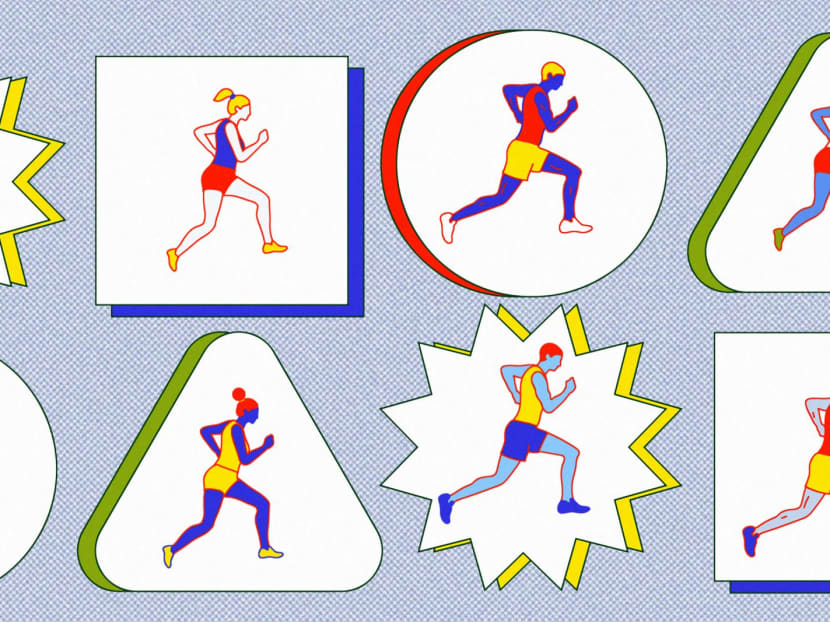To become a better runner, should you adjust your form? Here's what to know before changing yours
Many runners believe their natural stride could be improved. Here’s what to know before trying to change yours.

(Art: The New York Times/Petra Peterffy)
Want to get better at tennis? Fine-tune your serve. Swimming? Perfect your stroke. But what about running? If you improve your form – from your posture to the way your foot hits the ground – will that make you faster and more efficient?
On TikTok and Instagram, plenty of videos promise that the secret to faster running lies in refining your technique. And gait retraining services, which help people change their stride, have expanded beyond university biomechanics labs and into physical therapy clinics.
All of this can be confusing. “It reinforces the idea that running form is important and that most people are doing it wrong,” said Matt Fitzgerald, author of 80/20 Running and creator of Dream Run Camp, who has coached runners from ranging from beginners to Olympians.
But according to experts, there isn’t one ideal way to run. A recent review analysed 51 studies related to running biomechanics and running economy (a measure of how much oxygen you burn to maintain a certain pace, which is often used as a proxy for running performance) and found that characteristics of a runner’s form, like their stride length or whether they landed on their heel, didn’t make much difference.
When it comes to performance, “running technique does matter to some extent, but certainly not as much as many people try to make you believe,” said Bas Van Hooren, a sport science researcher at Maastricht University in the Netherlands and a semiprofessional runner.
LET YOUR BODY FIND ITS NATURAL GAIT
Your running form can be influenced by a number of factors, including your height, weight, muscle mass, body proportions and even the type of sports bra you wear. When left alone, “your body will self-optimise,” said Dr Van Hooren. As you run more regularly, your body adjusts and learns how to move more efficiently.
For recreational runners, especially beginners, jogging consistently and gradually building up your mileage will do more to improve your efficiency than finessing your form will, said Isabel Moore, an associate professor in human movement and sports medicine at Cardiff Metropolitan University. In one small study led by Dr Moore, beginner runners naturally refined their stride over the course of a 10-week walk-run programme without any specific instruction.
Focusing on changing your stride can be physically and mentally taxing, and it can even make you less efficient. “The whole gait cycle is less than one second,” Dr Moore said. “If you take 160 steps per minute and you’re running 30 minutes, that’s a lot of thinking.”
Altering your running form can also change the load on your body, increasing your injury risk, especially if your muscles and tendons haven’t adapted to handle the new stress, Dr Moore said.
LIFT WEIGHTS TO SUPPORT YOUR FORM
Strength training can help you build “a durable system” that enables your running stride to evolve, said Heather Vincent, director of the UF Health Sports Performance Center at the University of Florida.
Dr Vincent recommended multi-joint movements like squats, deadlifts and step-ups, as well as exercises that target muscles in the core and feet. Resistance training also increases muscle and tendon resilience and improves bone strength, which can improve your body’s ability to withstand the repeated impact of running.
Plyometric exercises like hopping or skipping can help, too, by improving how rapidly your legs can absorb and release energy, said Dr Van Hooren.
IF YOU’RE INJURY-PRONE, TRY ADJUSTING YOUR CADENCE
Some runners might benefit from one targeted change – increasing your cadence, or the number of steps you take per minute. Quick footsteps can keep you more aligned over your body’s centre of mass and prevent your foot from landing too far in front of you, said Dr Vincent. A faster turnover reduces the stress on three common sites for running injuries: The knee, Achilles tendon and shin.
Most fitness trackers measure cadence. While there isn’t one specific number to aim for, Dr Van Hooren said, if it’s below 160, for example, it could be worth increasing your step frequency. Find a playlist where the beats per minute match your goal cadence and run along with the beat of the music without increasing your speed.
To gauge whether a faster cadence is helping you, Dr Van Hooren suggests monitoring your heart rate before and after changing your step rate, while running at the same speed. If your heart rate is the same or lower, that’s a sign that you aren’t working as hard to run at the same pace.
Dr Vincent also reminds her clients to maintain good posture (shoulders back and chest up) and keep a little tension in their abdomens, “like you’re blowing out a candle,” while running. These small adjustments can help with alignment and control of your pelvis and hips while running, which can reduce the impact of each step.
But for most runners, the best advice is to not overanalyse. “Just keep running and stop focusing on how you run,” Dr Moore said. “Let your body do its thing without thinking about it.”
By Christine Yu © The New York Times Company
The article originally appeared in The New York Times.



